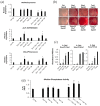Effective Osteogenic Priming of Mesenchymal Stem Cells through LNA-ASOs-Mediated Sfrp1 Gene Silencing
- PMID: 34452242
- PMCID: PMC8398380
- DOI: 10.3390/pharmaceutics13081277
Effective Osteogenic Priming of Mesenchymal Stem Cells through LNA-ASOs-Mediated Sfrp1 Gene Silencing
Abstract
Mesenchymal stem cell (MSC) transplantation has emerged as a promising approach for bone regeneration. Importantly, the beneficial effects of MSCs can be improved by modulating the expression levels of specific genes to stimulate MSC osteogenic differentiation. We have previously shown that Smurf1 silencing by using Locked Nucleic Acid-Antisense Oligonucleotides, in combination with a scaffold that sustainably releases low doses of BMP-2, was able to increase the osteogenic potential of MSCs in the presence of BMP-2 doses significantly smaller than those currently used in the clinic. This would potentially allow an important reduction in this protein in MSs-based treatments, and thus of the side effects linked to its administration. We have further improved this system by specifically targeting the Wnt pathway modulator Sfrp1. This approach not only increases MSC bone regeneration efficiency, but is also able to induce osteogenic differentiation in osteoporotic human MSCs, bypassing the need for BMP-2 induction, underscoring the regenerative potential of this system. Achieving successful osteogenesis with the sole use of LNA-ASOs, without the need of administering pro-osteogenic factors such as BMP-2, would not only reduce the cost of treatments, but would also open the possibility of targeting these LNA-ASOs specifically to MSCs in the bone marrow, allowing us to treat systemic bone loss such as that associated with osteoporosis.
Keywords: BMP; GapmeR; LNA-ASO; Sfrp1; bone regeneration; mesenchymal stem cells; osteogenesis.
Conflict of interest statement
The authors declare no conflict of interest.
Figures






Similar articles
-
Smurf1 Silencing Using a LNA-ASOs/Lipid Nanoparticle System to Promote Bone Regeneration.Stem Cells Transl Med. 2019 Dec;8(12):1306-1317. doi: 10.1002/sctm.19-0145. Epub 2019 Oct 21. Stem Cells Transl Med. 2019. PMID: 31631568 Free PMC article.
-
Ginkgo biloba extract promotes osteogenic differentiation of human bone marrow mesenchymal stem cells in a pathway involving Wnt/β-catenin signaling.Pharmacol Res. 2015 Jul;97:70-8. doi: 10.1016/j.phrs.2015.04.004. Epub 2015 Apr 23. Pharmacol Res. 2015. PMID: 25917209
-
Engineering a Pro-Osteogenic Secretome through the Transient Silencing of the Gene Encoding Secreted Frizzled Related Protein 1.Int J Mol Sci. 2023 Aug 3;24(15):12399. doi: 10.3390/ijms241512399. Int J Mol Sci. 2023. PMID: 37569774 Free PMC article.
-
Presenting a Method to Improve Bone Quality Through Stimulation of Osteoporotic Mesenchymal Stem Cells by Low-Level Laser Therapy.Photomed Laser Surg. 2017 Nov;35(11):622-628. doi: 10.1089/pho.2016.4245. Epub 2017 Jun 15. Photomed Laser Surg. 2017. PMID: 28621568 Review.
-
The shift in the balance between osteoblastogenesis and adipogenesis of mesenchymal stem cells mediated by glucocorticoid receptor.Stem Cell Res Ther. 2019 Dec 5;10(1):377. doi: 10.1186/s13287-019-1498-0. Stem Cell Res Ther. 2019. PMID: 31805987 Free PMC article. Review.
Cited by
-
Nanoparticle-mediated selective Sfrp-1 silencing enhances bone density in osteoporotic mice.J Nanobiotechnology. 2022 Oct 29;20(1):462. doi: 10.1186/s12951-022-01674-5. J Nanobiotechnology. 2022. PMID: 36309688 Free PMC article.
-
White Adipocyte Stem Cell Expansion Through Infant Formula Feeding: New Insights into Epigenetic Programming Explaining the Early Protein Hypothesis of Obesity.Int J Mol Sci. 2025 May 8;26(10):4493. doi: 10.3390/ijms26104493. Int J Mol Sci. 2025. PMID: 40429638 Free PMC article. Review.
-
The Current Progress of Tetrahedral DNA Nanostructure for Antibacterial Application and Bone Tissue Regeneration.Int J Nanomedicine. 2023 Jul 10;18:3761-3780. doi: 10.2147/IJN.S403882. eCollection 2023. Int J Nanomedicine. 2023. PMID: 37457798 Free PMC article. Review.
-
Conventional and microfluidic methods: Design and optimization of lipid-polymeric hybrid nanoparticles for gene therapy.Drug Deliv Transl Res. 2025 Mar;15(3):908-924. doi: 10.1007/s13346-024-01644-4. Epub 2024 Jun 13. Drug Deliv Transl Res. 2025. PMID: 38872047 Free PMC article.
-
Identification of the genetic central dogma in osteogenic differentiation of MSCs by osteoinductive medium from transcriptional data sets.Chronic Dis Transl Med. 2022 May 31;8(3):218-228. doi: 10.1002/cdt3.26. eCollection 2022 Sep. Chronic Dis Transl Med. 2022. PMID: 36161200 Free PMC article.
References
-
- He X., Dziak R., Yuan X., Mao K., Genco R., Swihart M., Sarkar D., Li C., Wang C., Lu L., et al. BMP2 genetically engineered MSCs and EPCs promote vascularized bone regeneration in rat critical-sized calvarial bone defects. PLoS ONE. 2013;8:e60473. doi: 10.1371/journal.pone.0060473. - DOI - PMC - PubMed
-
- Rodriguez-Evora M., Garcia-Pizarro E., del Rosario C., Perez-Lopez J., Reyes R., Delgado A., Rodriguez-Rey J.C., Evora C. Smurf1 knocked-down, mesenchymal stem cells and BMP-2 in an electrospun system for bone regeneration. Biomacromolecules. 2014;15:1311–1322. doi: 10.1021/bm401854d. - DOI - PubMed
Grants and funding
LinkOut - more resources
Full Text Sources

